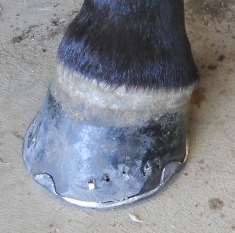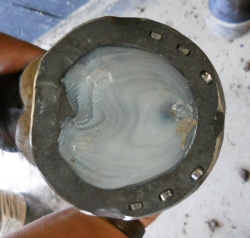A broken P3 (the third phalanx, or coffin bone) can sideline a racehorse for several months. It can be career-ending or just a temporary setback depending on the position and severity of the break.
Small fractures on the side of the bone are said to be wing fractures because they are located on the “wings” of the P3 bone. (picture1) They can actually separate the wing tip from the rest of the P3, or just compromise the structure with a hairline fracture in that area.
Wing fractures are the easiest to come back from when they do not involve the coffin joint. In picture 1 the bright shiny part in the top of P3 is the area of articulation between the two bones. Fractures that continue through the proximal (uppermost) end of P3 into the joint are far more difficult to recover from since they involve the articulation between P2 and P3, P2 being the second phalanx or short pastern bone.
Any time fractures involve a joint, the healed (calcified) bone may not be as smooth on the joint surface as it was originally, causing pain in that articulation (movement).



In any case, the first order of business for the farrier is to help stop the natural movement of the hoof capsule and help facilitate healing of the bone. The hoof cast mentioned in the previous article “Casting Out of Trouble” [March 2012 Hoof Beats] can be a good option.
Also, bar shoes with side clips (picture 2) to restrict the lateral movement will work. (Picture 3) Another consideration is the vertical movement of the sole; this can be addressed by using full pads with silicone underneath them, or by using a pour-in pack. Equi-pak (also shown in Picture 3) is a polyurethane product that goes into the hoof cavity as a liquid and sets up to a firm consistency in minutes. Most farriers will know how to get it. Even if you were using a cast on the hoof, I would still nail a bar shoe over the cast and fill it with pour in packing, or use pads and silicone.
It is not uncommon for foals to sustain P3 fractures. Foals usually recover completely because of the rapid bone development during their young age. Foals also have the obvious benefit of weighing only a fraction of an adult horse. To help foals heal faster, we usually glue on a 3/8-inch, thick polyurethane shoe. During the gluing process, I will add more glue in the sole of the hoof to take the place of pads or packing used on adult horses.
Remember, do not to use corrective shoes on foals with a P3 fracture. The lateral or medial extension shoe often used for correcting conformation will, by design, load the hoof unevenly. That is not ideal when recovering from a P3 fracture. In fact, in extreme cases of correction, it can be a contributing factor. With these foals, I will leave the shoe on a little longer than usual, say 4-6 weeks. We normally take the shoes off the foals sooner than that because is the hoof is growing so fast; however, considering a P3 break and restricted exercise, I think a foal is better served to leave the shoe on a little longer than the normal 2-4 weeks.
Always have a vet or farrier monitor the length of time a shoe is on your foal. Changing growth rates have a big impact on the optimum time a shoe should stay on any foal. The shod hoof will return to normal in one to two trimming intervals after the shoe comes off. In most cases of foals with a broken P3 one shoeing is often enough to get them sound again.
Whether the horse is a foal, racehorse, broodmare, or turnout, the key to guaranteeing its best chance for full recovery lies in early intervention. Shoe the horse as soon as possible. Pain management or sedation may be necessary for this step. If the horse is too uncomfortable to nail shoes on, glue them instead. After shoeing, restrict the horse’s movement and keep them quiet. Your vet will have different recommendations for, stall rest and time off based on the location and size of the fracture.
One thing is certain: getting your vet and farrier working together as soon as possible will afford your horse its best chance for full recovery and, when it is time for that horse to resume a normal routine, to start back on the right foot.
Veteran Standardbred farrier Steve Stanley of Lexington, Ky., authors a monthly column for Hoof Beats, the official harness racing publication of the U.S. Trotting Association. The American Farriers Journal Editorial Advisory Board member offers plenty of practical advice that will be of special interest regardless of the type of horses that you work with. Click here to read more from Steve Stanley's Hoof Beats series.








Post a comment
Report Abusive Comment